View basket (0 items $0.00)
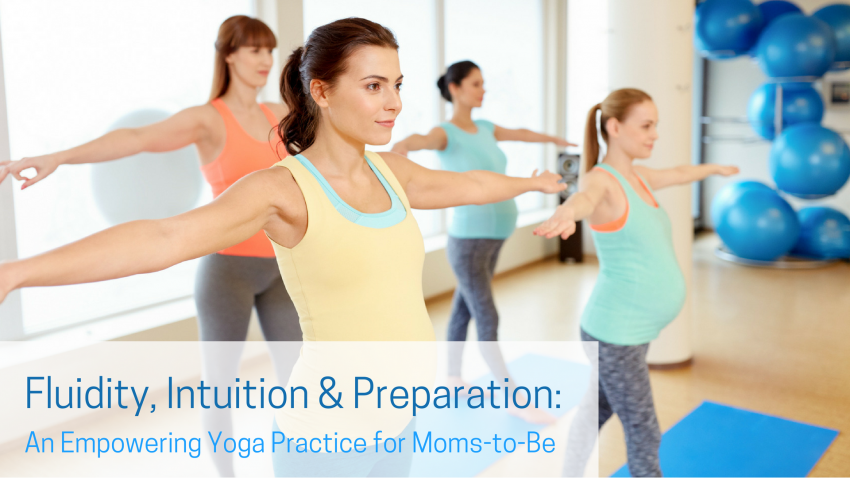
Prenatal Yoga Practice: Tending to Your Physical, Mental and Emotional Energy
Among the awe-inspiring things about pregnancy are the ways a woman’s body morphs to accommodate her growing baby. Consider the fact that her skin can stretch over her growing belly, that her abdominal muscles expand to this new, remarkable length, that her bones and joints adapt to carrying more size and weight, that her digestive system continues to function at all, not to mention the fact that her uterus grows from the size of an upside-down pear to a giant beach ball by full-term. It is extraordinary.
One remarkable change that is not so obvious to the naked eye, is the vast increase in blood volume coursing through a woman’s blood vessels during pregnancy. Blood vessel walls relax and dilate, allowing a greater volume of blood to flow easily through her body, making tissues more pliable. Circulating blood transports oxygen and nutrients to cells and eliminates waste and carbon dioxide. In pregnancy, blood flow is particularly directed to the areas of greatest need and growth: the breasts and the pelvis.
A woman’s body becomes more fluid-like in pregnancy. About half her weight gain in pregnancy comes from water. The percentage of fluids in a pregnant woman’s body increases from 60 percent to about 70 percent. Increased fluidity cushions a woman’s body and makes up the amniotic fluid, which protects her baby in utero. Meanwhile, newborns are about 73 percent fluids, which makes them malleable and resilient to stress.
Blood is composed of about 45 percent formed elements, including red blood cells (RBCs), white blood cells (WBCs), and platelets. About 55 percent of blood is plasma, which is mostly water. During pregnancy, red blood cells increase by about 20-30 percent, while plasma volume increases by at least 50 percent.
Red blood cells are diluted in plasma, and the blood gets thinner. This is a normal adaptation in pregnancy, and as long as a woman gets enough iron in her diet, she can avoid anemia.
Pregnancy also changes the plasma level of many clotting factors, such as fibrinogen, which increases more than three times its non-pregnancy level. High levels of fibrinogen support blood coagulation, which is a healthy adaptation in pregnancy to prevent postpartum hemorrhage. The increase in plasma plays a critical role in maintaining circulating blood volume, blood pressure and uteroplacental perfusion during pregnancy.
Posture influences a woman’s circulation and blood pressure dramatically. Being on your feet too long causes venous stasis or dependent edema and a drop in blood pressure. Lying on your back leads to low blood pressure or vena cava syndrome.
Increased fluids prepare your body for birth. The cervix, vagina and vulva become softer, fuller and more pliable in pregnancy. Increased blood volume also prepares your body for potential blood loss during birth.
Prenatal Yoga Practice
In prenatal yoga practice, I encourage women to meditate on their water quality: to find fluid qualities in their movement, in the ebb and flow of their breath. Transitioning easily between poses is the emphasis of this practice, rather than holding any pose for too long, in a static way. Practicing this way is gentle on joints, which soften in pregnancy, and helps women avoid sinking too deeply into joints, creating instability. 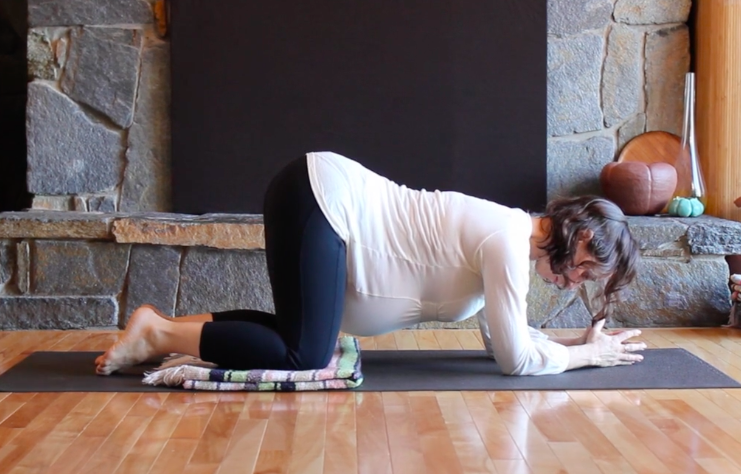
Everything I offer women in a prenatal yoga class is a suggestion. They decide for themselves what poses to include and what to avoid that day. In Bharmanasana (Tabletop Pose), I encourage them to move right away, swaying the hips from side to side, circling, or rocking forward and back. If wrists are painful from all that fluid, they place their forearms on the floor or on blocks. (See photo right). Their range of movement will be smaller, but their stability will increase. I encourage women to synchronize breath and movement, to visualize floating in gently undulating water.
A woman’s belly and baby are supported in Tabletop Pose by her abdominal muscles, ensuring the spine isn’t pulled toward the floor, pronouncing the curve in her lower back. This support creates space at the back of the pelvis, more like our four-legged friends who give birth with what seems like a lot less pain and tension than we have. Rather than emphasizing stretching, I encourage women to create space in the body, space for breath, space for her baby.
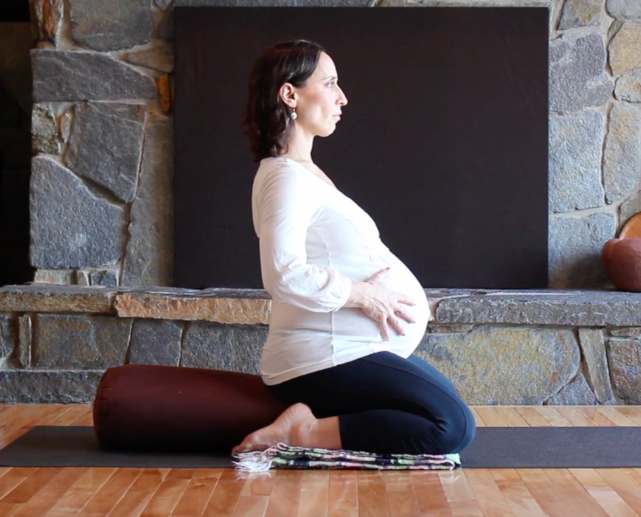
Balasana (Child’s Pose) (last photo below), Adho Muhka Svanasana (Downward Facing Dog Pose) (lower right), and supported Vajrasana (Diamond Pose) (left) are included in this flow. Women are guided to do what is useful, and disregard the rest. Practicing in this way brings a woman’s attention inward to observe, listen, sense and soften her physical, emotional, mental energy. She senses structural changes in her body—alignment, balance, aches and pains, laxity of joints, and the balance between stability and mobility. She assesses the qualities of her breath, its length, depth, rate and rhythm. She observes thoughts that arise, emotions that come to the surface, her level of energy, and whether she needs to slow down or pick up the pace.
I encourage women to move quietly, with intention and attention, articulating bones, muscles and joints. Conscious movement encourages circulation. When movement is infused with this kind of consciousness, it becomes a work of art.
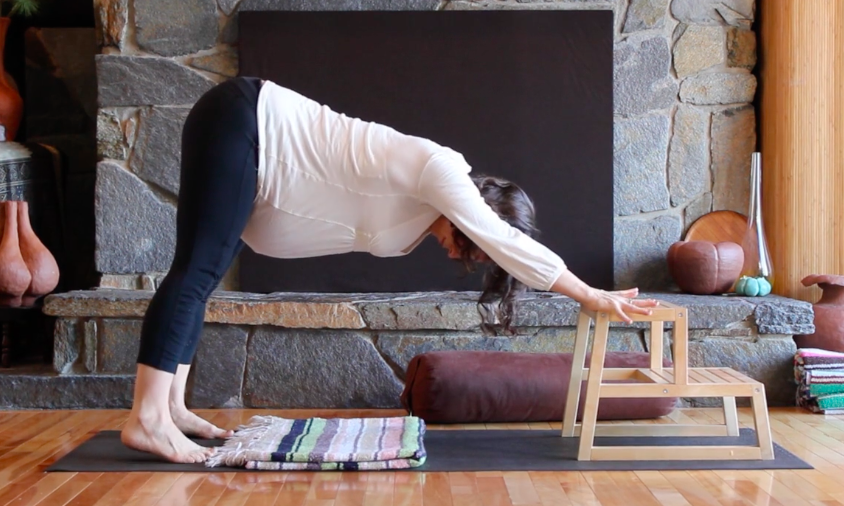
A Self-Directed Yoga Practice
A self-directed practice allows a woman to be with what is—physically, mentally, and emotionally. As a teacher, I provide instructions on what poses she might include and how to structure it safely. She directs the flow.
Encouraging women to listen deeply and observe the body, the breath, the thoughts and emotions teaches them to trust themselves, first and foremost. To trust their gut feelings, to be attentive to the deep visceral feelings that arise from their inner wisdom is a crucial message for women to hear, especially when they’re preparing to give birth.
Our birth culture has moved too far away from listening to women who trust themselves. Prenatal yoga practice can be a place to rekindle that level of listening and learning to trust. Like any muscle, our intuition gets stronger the more we honor and use it. The pacing of the class gives me, as the teacher, a chance to observe students—how they move, how they breathe—and guides the way I structure the rest of the class.
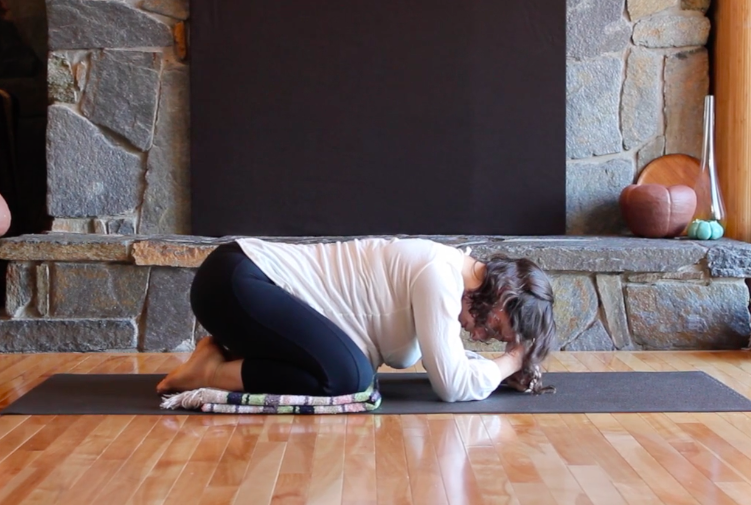 Postpartum Adaptations
Postpartum Adaptations
Emphasizing students’ water quality also reminds me to mention a crucial postpartum change. The body eliminates this excess water in the early days postpartum through perspiration, urination and tears. Some women will wake up in the middle of the night, when their bodies are in that healing, rejuvenating mode of rest, soaked in sweat, needing to change their clothes and bed sheets. By normalizing this postpartum adaptation, we eliminate fear and replace it with knowledge and laughter. It’s important that a woman knows what to expect and that there’s a wide range of normal around these adaptations.
Prenatal yoga is not just a physical practice. It can be a way for women to tend to their physical, mental, emotional and spiritual selves. Give women guidance and space to find their own pace in practice—and in motherhood.
Study with YogaUOnline and Lynn Jensen - Yoga for Healthy Hormones: Harmonizing the Cycles of Life.
photos courtesy of Josh Citron

Beth Donnelly Cabán is a Registered Nurse and childbirth educator who has been teaching prenatal yoga for 20 years. She directs the Prenatal Teacher Training Program at Integral Yoga Institute in NYC and is the consulting expert on The Essential Prenatal Yoga Video series.
Featured Courses








